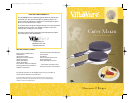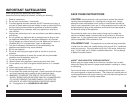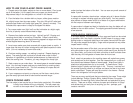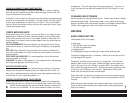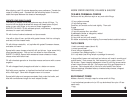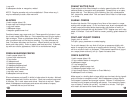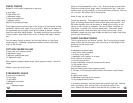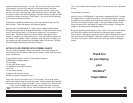
temperature. They will ìpeelî apart with just a gentle pull. If youíre in a
hurry, the stack can be warmed covered with foil on a flat pan in a low
oven.
CLEANING AND STORAGE
Remove plug from outlet and allow to cool. Simply wipe off with a slightly
dampened paper towel. Place crepe maker in any plastic food storage
bag so it remains clean and cooking surface is not subject to abuse when
storing. We suggest you retain the original carton for storage.
RECIPES
BASIC CREPE BATTER
Yields about 22 six inch crepes
4 large eggs
1 1/2 cups milk; more as needed
1 1/2 cups all-purpose flour
1/4 teaspoon salt
2-3 tablespoons butter, for basting the crepe maker cooking plate
Combine the eggs and milk in a blender. Add the flour and salt and mix
on high speed until smooth.
Separately, combine the flour and salt in a large bowl. Push the flour
aside to make a well in the center. Break the eggs into the center and
pour in 3/4 cup of the milk. Whisk in a small circle in the middle of the
well to blend the eggs and the milk. Whisking constantly, gradually draw
in the flour until you have a thick mixture. Add another 3/4 cup milk.
Whisk until the mixture forms a smooth batter.
Strain the batter (to remove any lumps) into a quart size measuring cup
with a spout or a pitcher. Let the batter rest at room temperature for 30
minutes.
Melt the butter small saucepan over medium-high heat, use a kitchen
brush to add a butter coating to the crepe maker cooking plate before
dipping & cooking.
USING A BLENDER TO MIX CREPE BATTER
The usual mixing method is to prepare crepe batter in a bowl, making a
well with the dry ingredients and then adding the eggs and the milk. You
may find a blender to be suitable
Ablender is not only fast, but the results are also lighter, perhaps because
more air is incorporated into the batter. For best results, have the ingredi-
ents at room temperature and donít over mix them. Then, let the batter
rest for half an hour before cooking to let the flour absorb the liquid, creat-
ing the most tender crepe.
CREPE SERVING HINTS
Starting with a pile of flat crepes, you can use them in a number of ways,
depending on whether you want a simple sauced or a fancy filled crepe.
They can be served cold, warm or hot, baked, broiled or crisp-fried in oil.
See recipes for the ways to use various shapes. Here are some ideas on
handling crepes:
FOLD IN QUARTERS: When served plain (or spread with a thin, filling)
and served in sauce, or used ìhot off the panî for dipping in an appetizer
dip.
ROLLED: When filled with a few spoonfuls of an entree or dessert mix-
ture and quickly baked or broiled, or filled with cold mousse, ice cream or
whipped cream.
FOLD INTO AN ENVELOPE: For small appetizers, ravioli-like entrees,
crisp-fried treats of all kinds.
STACKED: To make a cake (gateau) or in a casserole dish, with appropri-
ate fillings and toppings, served hot or cold.
KEEPING CREPES W
ARM
If you want to serve crepes, warm without baking, broiling or frying them,
simply cover the stack of crepes as they are made with a foil cover. Or
set a rack or perforated screen (such as a wire mesh spatter shield) over
a skillet with an inch of simmering water in it.
FREEZE OR REFRIGERA
TE YOUR CREPES
Crepes will keep up to a month in the freezer, a week in the refrigerator.
Simply stack a batch on a sheet of foil or waxed paper, insert into a large
plastic food storage bag and twist and fasten opening, pressing out
as much air as possible. To use, allow crepes to warm up to room
6
7



